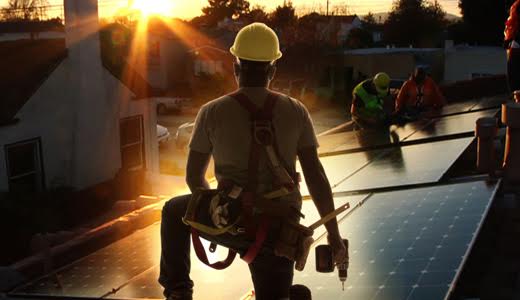
BEVERLY HILLS, Calif. – Just in time for Earth Day 2016, Catching the Sun, an informative and upbeat new film about solar power (seen April 11), will debut on Netflix on April 22.
In a brisk 75 minutes, director Shalini Kantayya introduces us to working people who want jobs in Richmond, Calif., site of a major 2012 Chevron refinery explosion that sent 15,000 people to local hospitals with acute breathing problems, and that also alerted a largely minority population of the dangers inherent in our fossil fuel culture. They find new careers and self-improvement in the burgeoning solar industry, which had not until now reached deeply into ethnic communities of America. Kantayya focuses this piece of her story on a young African American named Eddie
Wiltz who, in a sweet touch, by the end of the film has acquired a girlfriend in a fellow student.
We also meet Wally Zhongwei Jiang, a shining example of the new breed of Chinese entrepreneurs who are taking solar technology global – and capitalizing on trillion-dollar opportunities that, owing to its backward-looking allegiance to oil and coal, American capitalism is leaving on the table. Wally’s solar empire is growing by 50 percent annually.
And we encounter a conservative “Green Tea” activist from Georgia, Debbie Dooley, who surrenders nothing politically but is simply and practically advocating for solar as energy freedom – contradicting powerful right-wing forces such as ALEC and the Koch brothers. Her view echoes Wally’s, who succinctly says of China that “energy security is national security.”
A special adviser for green jobs
Among the others who populate this film we also get to know Van Jones, co-founder of Green for All, which advocates for “the greenest solution for the poorest people.” His thinking is that “Every child needs a ladder to climb” if we are ever to defeat soul-crushing poverty in America. In 2009 Jones answered the newly inaugurated President Barack Obama’s call to serve in the White House as a special advisor for green jobs. “I think we should retrofit every building in the United States,” he says. Jones is currently President of Dream Corps.
The U.S., with 5 percent of the world’s population, consumes 27 percent of the world’s energy. Many Americans now understand that this equation is unsustainable, not only ethically, but because both the domestic and the imported fossil fuel resources we depend on will not always be available, and because they contribute mightily to the problem of climate change. It’s time to rewire the world: It will be both cheaper and cleaner. Green jobs will grow exponentially as we convert. Van Jones wants to restore America’s greatness, but as the world’s #1 producer, not the #1 consumer.
An earlier president, Jimmy Carter, understood the challenge of converting to renewable energy as far back as the late 1970s. In fact, he had solar panels installed at the White House to set an example. This was a most unfitting precedent, however, for an industrial nation such as ours, believed his successor in the White House, who had them removed on his second day in office. That was, of course, Mr. Reagan. The revolving doors between fossil fuel executive suites and government offices have continued to spin ever since.
But Jones did not last long. The right-wing, and in particular the fossil fuels industry launched a full-court press against Jones, accusing him of being a radical, an anarchist, a communist – all by way of attacking Obama’s legitimacy as president. Starting with early “exposés” on Fox News, the rumor-mongering soon metastasized to the mainstream press until Van Jones became the symbol of everything dangerous about the Obama victory. So that it would not become the focus of the president’s first year in office, Jones opted to resign. It was “like being mugged in a parking lot,” Jones recalls. He has gone back to his non-profit work, and presently is also a news commentator.
During Obama’s first term the House passed cap and trade (The American Clean Energy and Security Act of 2009), a policy by which polluters exceeding their “cap” could offset their operations with monetary payments. But the smear campaign over energy got to the Senators in time for them never to take it up. In California, where cap and trade did pass in October of 2011, one-fourth of such payments, amounting to billions of dollars every year, are earmarked to be invested in poor and rural communities.
The revolution is all around us
Catching the Sun packs a vast amount of information, and presents it with warmth and humor. The local Richmond solar crew hook up radios, a fan, and a tiny music box to solar power, and as soon as the latter is properly wired, what song does it play? “You are the sunshine of my life!”
There are, of course, some leaders in the energy industry, such as the former coal-based NRG, who have seen the writing on the wall and seek to invest more in renewables. Eventually, company by company, city by city and state by state, the battle will be won, but the fossils will predictably hold us back for some time to come. As recently as the 2008 presidential election, Jones reminded us in a post-viewing panel, candidate John McCain agreed with the theory of global warming and also supported cap and trade policies. It’s come to the point now, as the crescendo of hate against Obama and liberalism has mounted, that to be a member of the conservative “tribe,” you must declare yourself against science. We see that over and over again in energy, medicine and health, and education.
Will the U.S. actually be able to build a clean energy economy? The prospects are not all dim by any means. The 2014 People’s Climate March signaled a major commitment by millions of Americans to move toward a green economy. And in 2015, at COP 21 in Paris, the U.S. joined dozens of other countries in legally binding mutual promises to reduce carbon emissions. Solar-powered homes and buildings are already commonplace; cars, phones and other machines will soon be able to be powered by the sun, and solar will become one of the world’s biggest employers.
The revolution is all around us, moving at different paces here and there, but inevitable. Already Germany supplies 75 percent of its energy needs with renewables, and other countries are approaching that level. The technology exists and is expanding, the infrastructure can readily accommodate more renewables, the labor force is ready to go to work, and the costs are declining precipitously. What holds us back is the political will, thwarted by forces in the economy still unweaned from traditional fuels. If the U.S. could pull together on this, we could have a majority renewable energy grid by the year 2030. (Which is why elections matter.)
Kantayya repeatedly uses the film technique of time lapse photography in all kinds of interesting, visually arresting ways. These quick-moving sequences are always beautiful to the eye – traffic rushing through an intersection, shadows moving across the landscape, clouds rushing past – but also signify how fast the world is changing nowadays. Blink and there’s a new solar-powered building over there; blink again and there’s a whole field of solar panels supplying energy to cities and factories. The disparate, but related stories, filmed in the U.S., China, Germany, India and elsewhere, are interwoven artfully.
The film director allowed her friend Van Jones to answer the lion’s share of questions during the panel discussion, and Jones did not disappoint. There is progress, and there is hope, he said, but “Congress is stuck on stupid.” Technology is getting better all the while, and he envisions a time, perhaps not too far off, when solar panels may be obsolete: “We’ll be able to spray solar onto walls.”
Jones is confident in the next generation of activists, who are persistent and well informed. But we have serious problems to overcome. For example, the ecology movement is far too identified with “save the polar bears” white people. Go into a lot of environmental groups and you’ll find a sea of pale faces – “eco-elitists,” Jones calls them. Such discrimination in hiring makes the movement vulnerable to right-wing attack: They can appeal to poor people and people of color and say, See, these movements are not your movements. Eco-apartheid will only lead to eco-apocalypse.
At the same time, he advised, it is critical not to see the 1 percent as all-powerful. “People’s movements matter a lot.” The elites are in disarray, “a zoo, a circus,” he says. “They’re less in control than they have ever been. Don’t get trapped in the amber of these conspiracy theories that are sucking the life out of our people.”
Eventually we will have a national solution and a smart, renewable grid. But in the end, Jones says, “It’s up to everybody to fight for the future they want.”
A trailer for the film can be seen here.
Catching the Sun plays at the Laemmle Music Hall, 9036 Wilshire Blvd., Beverly Hills, through April 14. For tickets and showtimes call the info line at (310) 478-3836, or visit www.laemmle.com.
Director: Shalini Kantayya
Writer: Shalini Kantayya
75 minutes
Photo: Catching the Sun website.












Comments